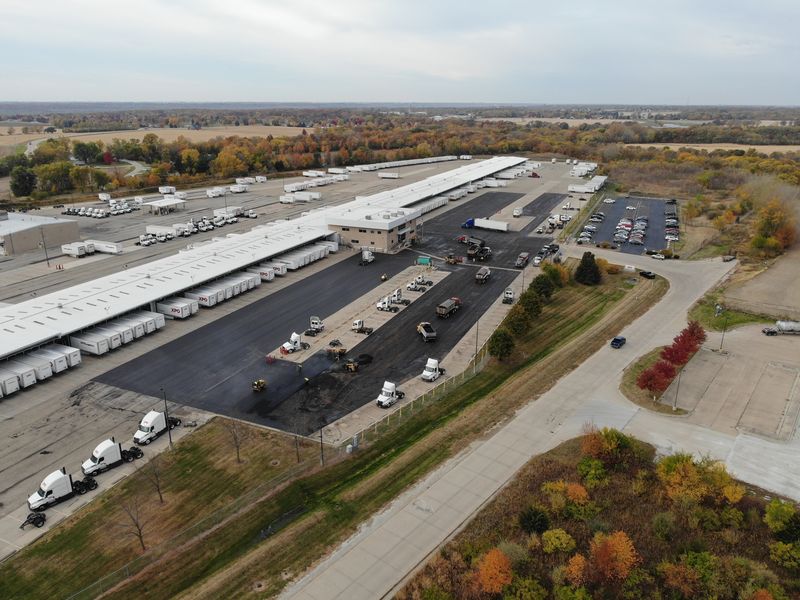Have you ever noticed how two parking lots of similar size can have wildly different price tags when it comes to paving? We’ve seen business owners and property managers scratch their heads, wondering why their neighbor got a much lower quote. Asphalt isn’t like buying a pair of shoes where the price is on the tag and that’s it. Every project has its own DNA. The ground beneath the surface, the traffic that rolls across it, and even the climate in your zip code quietly shape the total investment. The truth is simple: when it comes to the cost of commercial asphalt projects, the variables are many, and understanding them upfront saves money, time, and headaches.
And that’s where we at The Pavement Group come in. We’ve worked across Pittsburgh, Philadelphia, Cleveland, and other busy cities, and we’ve seen how local conditions, from rocky soils in western Pennsylvania to heavy snow in the Northeast change the entire cost picture. Let’s break it down so you can see exactly what matters most.
The Ground Beneath: Site Conditions and Preparation
One of the most overlooked cost drivers is the condition of the site before a single truck of asphalt arrives. If your property has poor drainage, uneven terrain, or old deteriorating pavement that needs to be milled down, that extra prep work adds dollars to the bottom line.
Think of it like building a house. You wouldn’t put up walls without making sure the foundation is solid. Asphalt is the same. A stable base prevents cracks and potholes later, while a shortcut on prep work guarantees you’ll be calling us back sooner than you’d like.
Materials and Mix Designs
Not all asphalt is created equal. Some mixes are engineered for high-traffic shopping centers where delivery trucks roll in daily, while others are designed for office lots with lighter car use. Using the wrong mix might save you a little upfront, but it can shorten the lifespan of your pavement by years.
Costs also shift with oil prices since asphalt is a petroleum-based material. That’s why quotes can look different from one season to the next. A pro tip? Ask your contractor what mix they recommend and why. It’s not just about the price per ton but the performance over decades.
Labor and Equipment
Here’s the thing about asphalt paving. It’s as much about the people and machines as it is about the blacktop itself. Skilled crews who know how to handle large-scale paving jobs bring efficiency and precision. Heavy-duty equipment like pavers and rollers doesn’t come cheap either, but the right machinery ensures smoother finishes and longer-lasting results.
If you’ve ever driven on a bumpy road where the asphalt looks lumpy, that’s usually the sign of poor technique or underpowered equipment. Investing in experienced crews and modern equipment might nudge the price up, but it pays back in years of durability.
Project Size and Layout
A big lot isn’t always a more expensive lot when you look at cost per square foot. In fact, larger projects often benefit from economies of scale because once the equipment is mobilized, crews can work more efficiently.
The layout, however, adds complexity. A sprawling shopping center with islands, medians, and tight corners takes more time and attention than a straightforward warehouse lot. That difference shows up in the bid. This is one factor in commercial asphalt project cost.
Traffic Loads and Usage
Picture the difference between a daycare parking lot and a major freight distribution hub. The daycare sees SUVs, minivans, and sedans all day. The distribution hub has 18-wheelers pounding the pavement around the clock. Obviously, the second one needs a thicker asphalt base and a stronger mix.
That thickness means more material, more trucking, and more labor. If your property welcomes heavy vehicles, expect the cost of your commercial asphalt project to rise accordingly.
Weather and Regional Climate
Here in Pennsylvania and Ohio, we fight freeze-thaw cycles every winter. Water seeps into tiny cracks, freezes, expands, and makes those cracks even bigger. That’s why we often recommend thicker pavement or specific mixes for colder climates.
Meanwhile, in southern markets, UV exposure and heat can soften asphalt faster. Local climate isn’t just a footnote. It’s a cost factor that shapes design, material, and maintenance schedules.
Accessibility and Logistics
Getting materials and equipment onto your property can make or break a project budget. If your site has tight entrances, limited staging space, or is located in a busy downtown corridor, crews spend extra time coordinating logistics.
Simple example: a wide-open suburban warehouse lot costs less to pave per square foot compared to a crowded city lot surrounded by buildings. Accessibility always plays into the bottom line.
Timing and Seasonality
Believe it or not, the time of year matters. Asphalt plants operate seasonally in northern states, so demand skyrockets in spring and summer. That demand drives prices higher. On the other hand, late-season work sometimes comes with discounts if crews are trying to fill their schedules before the plants shut down for winter.
If you’re a property manager planning ahead, locking in your project early can help secure better rates.
Long-Term Maintenance Plans
This one surprises people. Some contractors just pave and leave, while others (like us at The Pavement Group) recommend a full maintenance plan including sealcoating and crack sealing. The upfront cost might feel higher, but when you extend the lifespan of your pavement by five or ten years, the total cost of ownership is lower.
Don’t just compare quotes, compare strategies when it comes to cost of commercial asphalt projects.
Build Pavement That Lasts: Get Your Free Estimate Now!
Your commercial asphalt project is more than just pavement. It’s a long-term investment in your property’s value, safety, and curb appeal. Knowing the factors that influence costs empowers you to make smart decisions and avoid surprises.
If you’re planning a paving project in Pittsburgh, Philadelphia, Cleveland, or nearby areas, let’s talk. The Pavement Group brings local knowledge, expert crews, and a no-nonsense approach to every job.
Call The Pavement Group today for a free, no-obligation estimate and see how we can save you money while building pavement that truly lasts.
Frequently Asked Questions
1. What affects the cost of commercial asphalt projects the most?
The biggest factors include site conditions, materials, and traffic loads. A project with poor soil and heavy truck traffic will naturally cost more than a small light-use lot. Choosing the right mix upfront reduces long-term expenses.
2. How does project size impact asphalt costs?
Larger projects often cost less per square foot because of economies of scale. However, layouts with lots of islands or tight corners can increase costs. It’s not just about size but also about complexity.
3. Do asphalt prices change by season?
Yes, asphalt prices fluctuate with demand and plant operations. In northern states, spring and summer bring higher costs due to peak demand. Late-season work can sometimes save money if scheduled strategically.
4. Why is site preparation important for asphalt paving?
Site prep ensures a strong foundation for the pavement. Without proper grading, drainage, and base materials, asphalt deteriorates quickly. Good prep protects your investment and reduces future repairs.
5. How does traffic volume affect asphalt thickness?
Heavier traffic requires thicker asphalt layers and stronger mixes. Light-use lots need less reinforcement. The more vehicles your pavement supports, the more material is needed.
6. Can climate influence asphalt costs?
Absolutely. Freeze-thaw cycles in northern regions demand thicker pavement and specific mixes. In hotter climates, UV resistance matters. Local weather conditions shape both design and cost.
7. Why do equipment and labor costs vary?
Modern paving equipment and skilled crews deliver smoother, longer-lasting results. Older machines or inexperienced crews may lower bids but increase risks. Investing in quality labor ensures durability.
8. How can accessibility impact asphalt project costs?
Sites with tight access, limited staging, or busy surroundings require extra logistics. Easy-to-access suburban lots are usually more affordable per square foot. Accessibility directly affects crew efficiency.
9. Is maintenance really part of project costs?
Yes, long-term maintenance protects your pavement investment. Sealcoating and crack sealing extend lifespan and reduce major repair costs. Ignoring maintenance leads to higher expenses later.
10. How do oil prices affect asphalt costs?
Asphalt is petroleum-based, so prices often track oil markets. When oil prices rise, asphalt costs follow. That’s why timing and market awareness matter.


